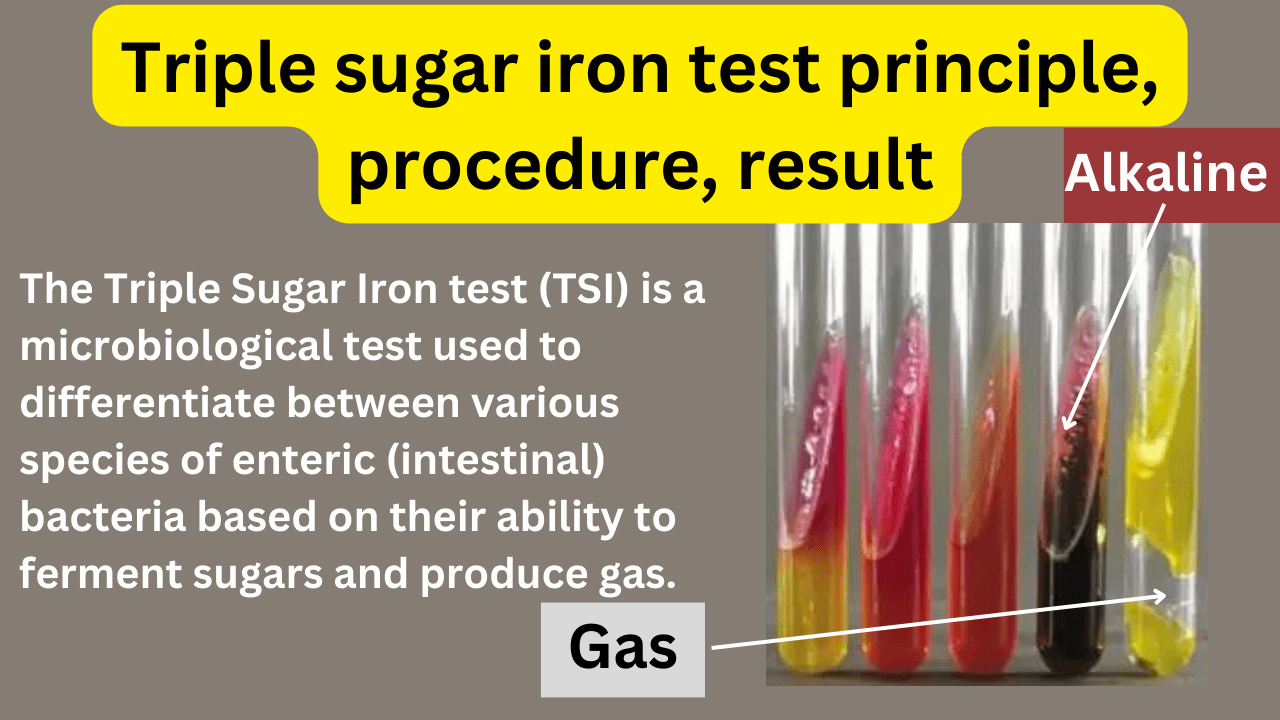The Triple Sugar Iron test (TSI) is a microbiological test. It is used to differentiate between various species of enteric (intestinal) bacteria. This is based on their ability to ferment sugars and produce gas.
Triple sugar iron test principle
The Triple Sugar Iron (TSI) test is a differential agar slant test. It is used to differentiate enteric bacteria based on their ability to ferment sugars. The test also checks for gas production.
The TSI agar medium contains three sugars: glucose, lactose, and sucrose, along with ferrous sulfate as an indicator.
The principles of the TSI test are
- Sugar Fermentation: The test determines whether the bacterium can ferment any of the three sugars in the medium. These sugars are glucose, lactose, and sucrose. Fermentation of these sugars results in the production of acids.
- Gas Production: Gas formation as a result of sugar fermentation is also observed.
- pH Indicator: Phenol red is used as a pH indicator. An acidic environment turns the indicator yellow, while an alkaline environment keeps it red.
Triple sugar iron test procedure
- Inoculation: A pure culture of the bacterium under investigation is streaked onto the slant surface of the TSI agar tube.
- Incubation: The inoculated TSI tube is then incubated at 35-37°C for 18-24 hours. The incubation period allows the bacterium to grow and ferment the sugars in the medium.
- Interpretation:
- Slant (top portion of the tube):
- Red: If the slant remains red, it indicates that no sugar fermentation has occurred on the slant portion.
- Yellow: A yellow slant indicates acid production from the fermentation of one or more of the sugars.
- Butt: (bottom portion of the tube):The combination of the slant and butt color and the presence or absence of gas helps interpret the results:
- A/A: Acid in both the slant and butt, indicating that the organism ferments glucose, lactose, and/or sucrose. Gas production may or may not be present.
- A/AG: Acid in the slant and butt, with the production of gas. This indicates the organism ferments glucose, lactose, and/or sucrose and produces gas.
- K/A: Alkaline (red) in the slant and acid in the butt, indicating that the organism only ferments glucose. No gas is produced.
- K/AG: Alkaline in the slant and acid in the butt, with gas production. This result suggests that the organism ferments glucose and produces gas.
- K/K: Alkaline (red) in both the slant and butt. This indicates no sugar fermentation by the organism.
Interpretation of TSI Results
The results of the TSI test are typically reported in the format of “Slant/Butt.” In this format, “K” represents alkaline (red). Meanwhile, “A” represents acid (yellow) conditions.
Here are some common TSI test result patterns and their interpretations:
- A/A: The organism ferments glucose, lactose, and/or sucrose with or without gas production.
- A/AG: The organism ferments glucose, lactose, and/or sucrose and produces gas.
- K/A: The organism only ferments glucose without gas production.
- K/AG: The organism ferments glucose and produces gas.
- K/K: The organism does not ferment any of the sugars.
These results can be used to help identify and classify the enteric bacteria under investigation. Different bacterial species have characteristic TSI test patterns, which can aid in their identification. The TSI test is often used with other biochemical tests for a more precise identification.

3 thoughts on “Triple sugar iron test principle procedure result”